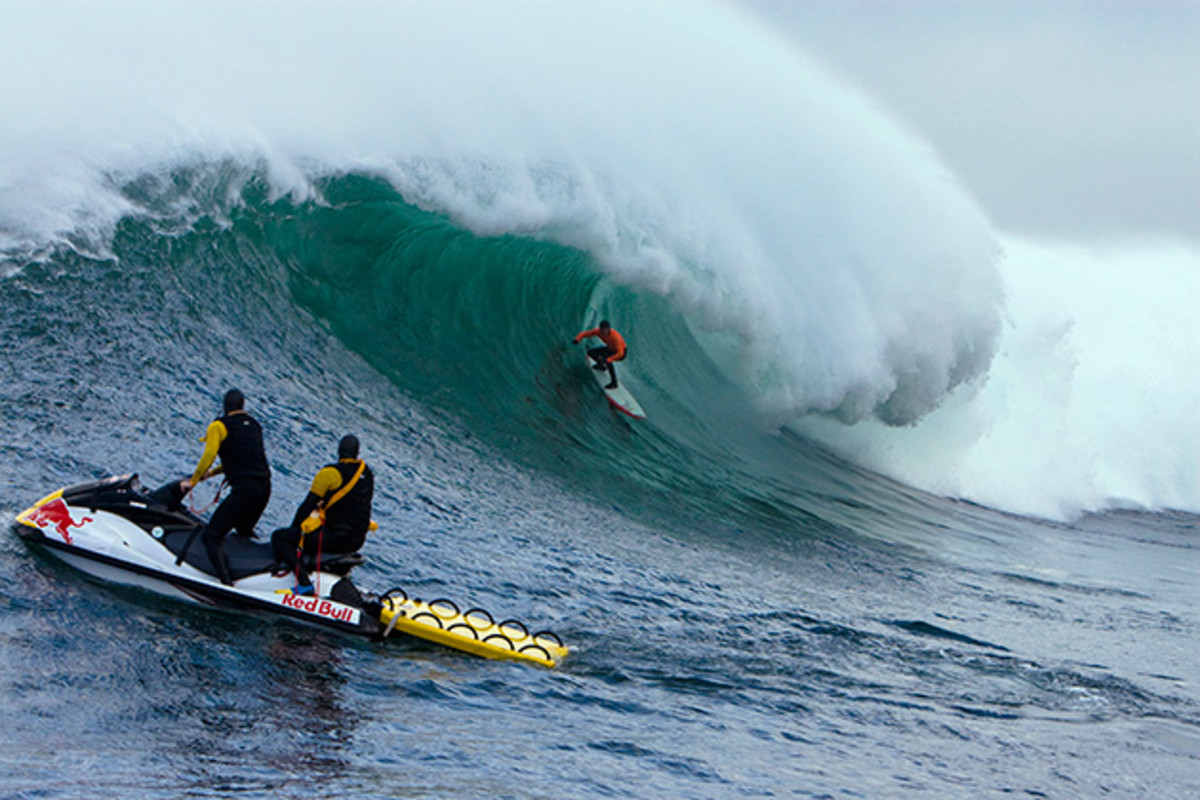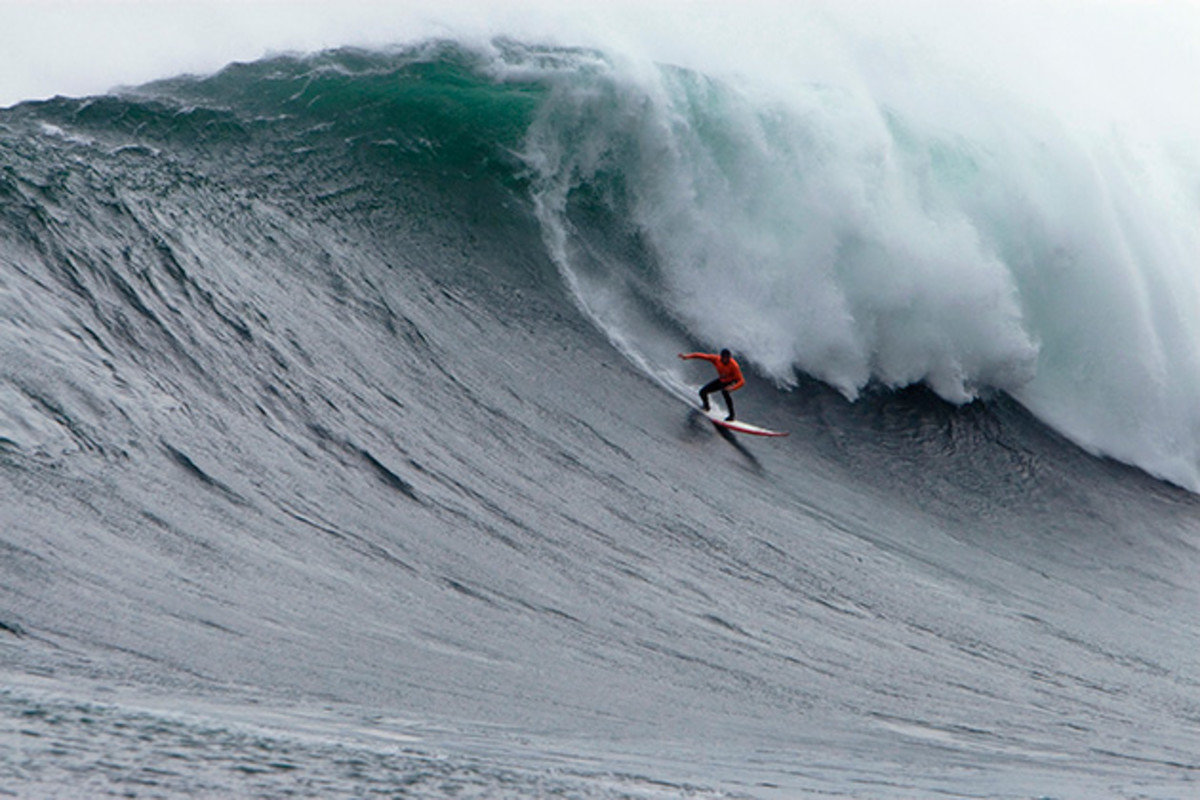The Greatest Wave: Greg Long's near-death experience changed everything

Greg Long had spent more than 15 years of his life chasing big waves. Surfing giants was all about the rush, the adrenaline, the achievement. Finding bigger and better waves, pushing his personal limits. But surviving big waves? That was all about preparation.
“There’s consequences to what we do,” Long says. “Each one of those boxes we don’t check as far as the preparation, it’s just opening up a slightly larger margin for error for something to go wrong.”
In December 2012, on his never-ending quest to ride the greatest wave of his life, something did go wrong. Long was held under by a set of mammoth 50-foot waves at Cortes Bank, an underwater sea mount 90 miles southwest of Los Angeles. Six minutes later, unconscious and just barely alive, he was pulled to safety and given oxygen aboard his support boat.
Long is known among the big wave riding community for his meticulous attention for detail. Ultimately, it was that obsession that saved his life.
***
The waves only get big a handful of times a year at each break, when the conditions are just right. Long learned early on that through careful preparation he could make the most of those opportunities. And on each one of those days, Long patiently waits hour upon hour for quality, not quantity.
“I go out with the intention that I’m going to catch two or three,” Long says. “I’m going to only wait for the very biggest or the very best.”

Years of experience have taught him to spot those waves in a set that approach perfection, the ones that will break just right. At home he keeps constant watch on the weather, scouring the web, monitoring storms and swells. He has his equipment neatly ordered, ready to go. “Unless you’re out there in the water, you’re not going to have an opportunity to catch that wave,” he says. Sometimes he’ll get as much as 72 hours warning, sometimes as little as 24.
In the early afternoon of Dec. 21, 2012, he’d caught his first wave of the day. It was big, maybe too big. He fell forwards off his board, wiped out spectacularly. He caught his breath, replaced a damaged leash, then turned around and paddled back to start the long wait for the next.
When that wave came, it was smaller, didn’t feel as spectacular. But he dropped in a little deep and couldn’t surf back out to escape the breaking whitewash. As the mountain of ocean dragged him under he took one final deep breath.
On every big wave hunting expedition Long brings about four boards and a handful of leashes. Leashes snap and boards break, and he wouldn’t want to miss the wave because of something as simple as an equipment failure. In case anything does go wrong, he wears an inflatable wetsuit, and his team carries CPR and first aid equipment either on jet skis or, when possible, a nearby boat.
How the world’s top big wave surfers get ready for the sport’s biggest event
As the whitewash dragged him under, Long reached across to his left shoulder and grabbed the ripcord on his wetsuit. Pulling this would puncture a CO2 cartridge tucked between his shoulder blades. A bladder on his upper body would inflate like a life vest, and he would pop safely back up to the surface. He tugged. Nothing. He yanked the cord again, still nothing. Maybe he’d pulled too hard, damaged the release spring, or maybe the force of the wave had knocked the cartridge out of place. Whatever had gone wrong, he would have to get back to the surface with his own power.
Stay down for the following wave or swim for the top? If he reached the surface, the next wave would almost certainly drag him back down, but he’d have a chance to grab a quick breath.
This was why he spent all those hours on a mountain bike, out trail running, doing hill sprints. His arms got enough exercise paddling for waves, but the land workouts trained his legs and heart for when he needed them. Long kicked for the surface.
Wave number two caught him early, still a few feet from the top. It hit him with the force of a collapsing building, crushing the remaining breath from his lungs and throwing him deep down into the ocean. “When that lip hit me the physical violence was indescribable,” he says. He’d been relaxing, ready to take that breath, now it felt like he was being torn apart. He was right back where he had started moments before, but now his chest was squeezed empty. His lungs convulsed, yearning for air.
Two-wave hold-downs are nothing special for big wave surfers. Long would practice breath-holding techniques on dry land and in the pool. He did yoga everyday, not just improving strength and flexibility, but training his mind. In perfect conditions Long can hold his breath for five-and-a-half minutes.
But these weren’t perfect conditions. He was alone, deep under some of the most violent waves on Earth, and his lungs were empty.
“At that point,” Long says, “I knew I was running out of time.”

As the third wave crashed harmlessly above him, he fought the desperate urge to breathe, the spasms in his chest muscles. “That’s where the mental training came in,” he says, “the ability to just tune everything out that I was feeling physically and find that state of peace and contentment.” He could feel the turbulence in the water from the passing wave. He didn’t have time to wait until that subsided to swim for the surface, his body just didn’t have enough oxygen left. He had to fight upwards. So he grabbed hold of his leash and slowly crawled hand over hand, dragging himself to safety.
A couple of weeks before, on a break called "Jaws" off the coast of Pe’ahi, Maui, he’d lost three boards in one hour on the rocks when the leashes snapped. The one strapped to his ankle now was a redesign: tougher, stronger. “If I had not had that new leash,” Long explains, “they would never have been able to find me.” Because it was still attached to him, the crew above knew where he would surface. The weight of his body on the leash held the board upright, a marker buoy signaling his location.
Fighting through the whitewater was difficult, but he’d survive, if a little battered and bruised. He’d grab a much-needed breath, weather the fourth wave, and get picked up by his crew. “I got to the tail section of my board,” Long says. “I let go of my leash, took one last stroke.”
Then... darkness.
Swell Matters: The wave science behind Mavericks
Just before the next wave hit, jet ski rider Jon Walla spotted Long’s body pop up to the surface, unconscious, floating face down. But there wasn’t time to grab him. Walsh had to back out and wait for the next wave to roll through.
Over the years, Long had assembled a team of surfers and supporters who would drop anything at a moment’s notice to join an expedition, and whom he trusted completely. “Surfing is a very individualist sport,” Long says, “but with big wave surfing you accomplish so much more when you work with a team.” That day he had fellow warriors Shane Dorian, Grant “Twiggy” Baker, and Ian Walsh to face the waves with him, and six jet ski riders for support and rescue.
After the fourth wave, D.K. Walsh powered in and jumped from his jet ski, abandoning it. He grabbed on to Long’s apparently lifeless body and wrestled the two of them through the fifth wave. Walla and Frank Quirarte then zoomed in with a rescue sled, and Long was finally dragged out of the water. As they sped back to the support boat, Long’s body suddenly sat bolt upright, spewed blood and foam into the air, took one desperate gasp of breath, then collapsed back down. He was still unconscious, possibly seriously injured, but he was alive.
“There’s consequences to what we do. Each one of those boxes we don’t check as far as the preparation, it’s just opening up a slightly larger margin for error.” —Greg Long
As he was finally airlifted to safety off the deck of the boat by a U.S. Coast Guard helicopter, Long swore to himself that he was done chasing big waves. Yet four weeks later he was paddling back out for a competition at Mavericks, near Half Moon Bay, California. “And then I was right back to my old ways,” he says, “chasing every single swell.”
“But the world wasn’t going to let me off that easily.”
He tried to go back to normal, but every time he wiped out, he panicked, paralyzed by fear, immediately grasping for the ripcord on his inflator. Long had built his life around big wave surfing, but there was no joy to be had out there anymore. “It was the furthest thing from being fun,” he says, “that’s really what broke me down. … This is my passion, and now I’m miserable when I’m doing it.”
Before the accident, everything had come second to chasing big waves; hobbies, friends, family, and relationships mattered less than where the next swell was going to hit. But the only way back now was to seek balance in his life.
So Long, 32, finally slowed down, learned to enjoy the land as much as the water. He went on a solo trek through the Sacred Valley of the Incas high in the Peruvian Andes, far up away from the ocean. He put more energy into working with environmental organizations, including Sustainable Surf, an organization based in his home state of California that aims to use surfing as a catalyst to solve environmental problems. He learned that it doesn’t matter if he misses the occasional swell. And without the internal voice constantly pushing him to ride bigger and badder waves, Long found himself enjoying big wave surfing more than he ever had before.
He still considers himself a work in progress. He’s still trying to come to terms with what happened that day in late 2012, and when he talks about it those emotions still bubble up to the surface. But in a strange way he is grateful not just for surviving, but for the whole experience, how it has transformed his life. He didn’t plan to almost drown; all he wanted to do was find the best wave. Perhaps he did.
“That was the greatest wave of my life,” he says.
